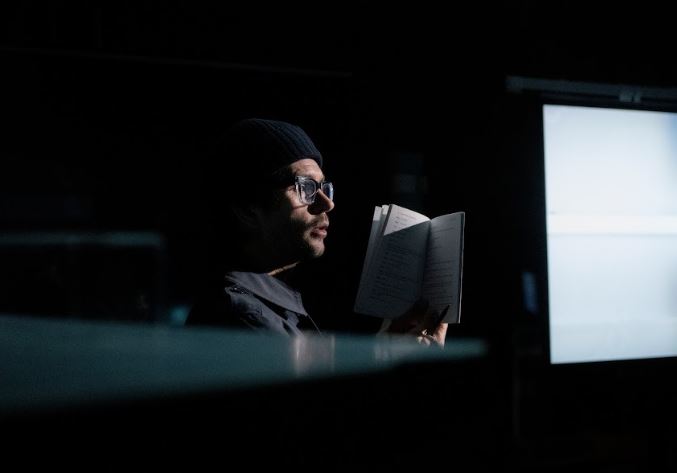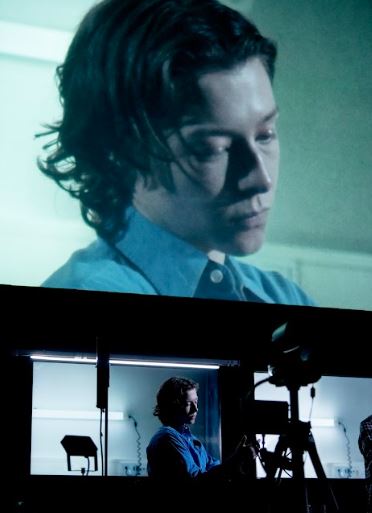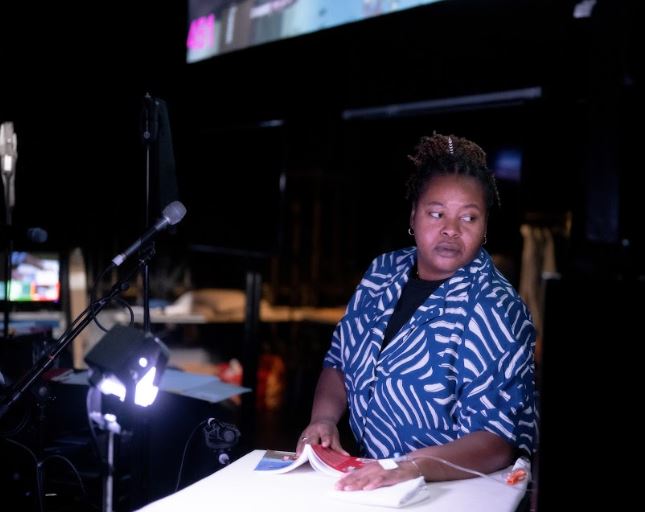Bluets
Blue Chip
Bluets
by Margaret Perry, adapted from the book by Maggie Nelson
Deutsches Schauspielhaus at the Jerwood Downstairs, Royal Court Theatre until 29th June
Review by Harry Zimmerman
Bluets is a story about depression and desire, pleasure and pain, and an individual possessed by a lifelong obsession with the colour blue. Communing with artists like Joni Mitchell, Derek Jarman, Andy Warhol and Billie Holiday, blue is their constant companion as they navigate the devastating pain of a romantic heartbreak, cope with a serious injury to a close friend, and, overwhelmed by loss and despair, contemplate suicide.
Yet these bald facts do not even start to tell the story of an experience that defies convention and weaves a melange of theatricality and cinematic sharpness that is simultaneously immersive and gripping.
Based on acclaimed author Maggie Nelson’s book, Bluets is an adaptation by playwright Margaret Perry, directed by Katie Mitchell. It is presented in the “Live Cinema” format, a hybrid art form between theatre and film.
Suppose I were to begin by saying that I had fallen in love with a colour
In its simplest form, the narrator central to the story fixates on the colour blue. Beads, marbles, sky, clothing, water, bottle tops, dyes, painted walls, precious stones, birds, bottles of ink, indeed anything which possesses the slightest hue or shade of blue, becomes an obsession and a leitmotif as she lurches from philosophy and science to art and music in an attempt to make sense of her life up to this point, and seeks to find a way through her pain and grief.
The thoughts and emotions of the unnamed woman whose experiences we are following are splintered across four video screens, and between three actors speaking into microphones and cameras, supplied with different sets of tabletop props and costumes by a fantastically well-drilled stage management team.
The three actors, Ben Whishaw, Emma D’Arcy and Kayla Meikle, are referred to merely as A, B and C, emphasising that this story is timeless, and nameless. What we are watching is not confined to a time, place or person.
They split the monologue seamlessly across their three voices and interact with recorded background film on the small screens behind them, and the larger one above. They change shirts, complete each other’s sentences and manipulate materials for images projected on to a screen behind them, whether that be a sheet and pillow for a bed or a cannula inserted into a hand. Sometimes they are reduced on screen to just a hand, a mouth, a side profile or a side-long glance.
It is a massively complex fusion of technology and technique and is flawlessly done.
Much of the recorded sequences which form the visual backdrop of the show, are commonplace, almost dreary in their banality. The actors are filmed walking down a street, in a café, on the tube, behind the wheel of a car, on a beach, in a changing room, in a swimming pool, on a bridge or in an office.
As these images play across the screens, with accompanying references to a collection of blue objects, and the ongoing attempts to seek out the colour where possible, a darker idea seeps into the narrative, as the association of blue with depression takes centre stage.
Here, the cold tone of the camerawork, supported by the fragmented dialogue effectively conveys the development of the narrator’s depression and her battle to find a way through her challenges.
There is a curious, dreamlike atmosphere to this show, as though the audience is almost intruding on the thoughts of the narrator in a weird kind of out-of-body experience.
Emma D’Arcy, Kayla Meikle, and Ben Whishaw deliver magnetic performances, their synergy palpable in every glance and poignant line. The way they keep the narrative moving, sharing their lines with split-second precision, being in exactly the right place at exactly the right time for each other’s next scene is a tour de force.
But in this production, they are just one element of a seamless whole. The stage crew are magnificently well drilled, providing and removing props with pinpoint accuracy, producing costumes at exactly the right moment and always helping to drive forward the narrative. One example of this is where each of the actors is fanned by a crew member to replicate standing on a windy beach. It is to their everlasting credit that, during the course of the production, the crew are not noticed. Working as one with the actors, they deliver an ongoing set of transitions and segues that are amongst the slickest I have ever seen in professional theatre.

In his notes to this production, the Royal Court’s Artistic Director, David Byrne, reveals that these performances of Bluets will never be repeated.
If this is the case, then it can truly be said that the audience has been treated to a genuinely unique experience, and anyone fortunate enough to obtain a ticket will experience a powerful hit of perfectly dovetailed artistic synchronicity.
Bluets is an ambitious, absorbing, disconcerting, sometimes discombobulating but always challenging piece of theatre, which will linger long in the memory.
See it if you can.
Harry Zimmerman, June 2024
Photography by Camilla Greenwood




